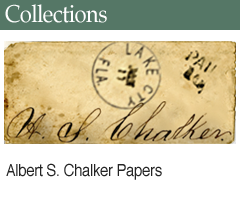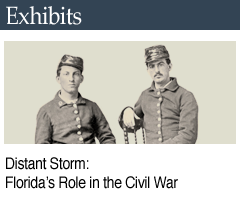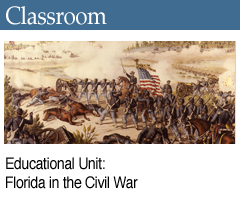Thomas Benton Brooks Papers
About These Records
Thomas Benton Brooks was a military engineer and aide-de-camp to General Quincy Adams Gillmore, who commanded the Union Army’s Department of the South from June 1863 to July 1864.
This collection consists mainly of correspondence and reports relating to Brooks’ activities in northeastern Florida in 1864, including a mission to confiscate lumber mills and their products for the use of the Union Army. Brooks also helped lead the effort to restore enough of the railroad between Jacksonville and Lake City to facilitate the Union campaign that culminated in the Battle of Olustee.
A key component of the collection is Brooks’ letterbook, which contains copies of his outgoing correspondence written between February and May 1864. The letters document his time in Florida as well as his leadership as an engineer in the Union Army’s 10th Corps during the Peninsula Campaign. The final entries in the letterbook illustrate Brooks’ involvement in preparations for the Battle of Drewry’s Bluff.
The collection also contains a few items not connected specifically to Thomas Benton Brooks, including several banknotes, travel passes for civilians and an 1857 broadside announcing a reward for the return of an enslaved woman named Eliza.
This collection is particularly valuable for its illustration of the critical and varied work of military engineers during the American Civil War. Brooks’ letters document a wider range of assignments, including developing a uniform system of steam whistle communication, constructing wharves and earthworks and designing obstructions to slow down the enemy’s advances.
Background
Thomas Benton Brooks was born June 15, 1836, in Monroe, New York. His engineering career began at the age of 16, when he joined a surveying crew working for the New York & Erie Railway Company. He started out as an axeman, clearing pathways for taking measurements, but he quickly rose to higher positions of responsibility in the crew. He later served as an assistant to the city engineer of Paterson, New Jersey, and was involved in surveying expeditions in both New Jersey and Florida.
Having obtained this practical experience, Brooks entered Union College in Schenectady, New York, to study engineering, and he taught classes there briefly after graduating in 1858. He also studied topographical geology at the University of Pennsylvania under the tutelage of that state’s chief geologist, J.P. Leslie.
Shortly after the Civil War broke out in 1861, Brooks enlisted in Company A of the First New York Volunteer Engineers, receiving a commission as first lieutenant. He attained the rank of captain, and then major following his outstanding work as an engineer during the Union attacks on Fort Pulaski near Savannah, Georgia, in 1862, and Fort Wagner near Charleston, South Carolina, in 1863.
When General Quincy Adams Gillmore took command of the Union Army’s Department of the South in June 1863, he selected Major Brooks as his aide-de-camp. Gillmore deployed Brooks as a troubleshooter for several operations, including an expedition up the St. Marys River in February 1864 to capture and transport a massive amount of lumber that had been milled by Confederate citizens. The mission required great delicacy—Confederate defenders were ready to burn the lumber and the mills if they were likely to fall into Union hands. Major Brooks and his fellow commanders were successful in confiscating 700,000 board feet of yellow pine lumber for military use.
While in Florida, Brooks also consulted on the problem of transporting a locomotive and other rolling stock from Fernandina to Jacksonville for use in the 1864 campaign to penetrate into Middle Florida. With the bridges connecting Amelia Island to the mainland severed, Brooks concluded the best solution was to move the locomotive and cars to Jacksonville by boat, and he helped supervise the effort to build a new wharf at Fernandina to facilitate this task.
In May, General Gillmore and the Army’s 10th Corps were transferred to the Army of the James, which was then engaged in the Peninsular Campaign in Virginia. Thomas Benton Brooks continued in his role as Gillmore’s aide-de-camp and also served as the corps’ directing engineer. He was wounded in the arm on May 16, 1864, during the Battle of Drewry’s Bluff.
This injury, combined with the death of his brother and his parents’ request for him to return home, led Brooks to resign his post in October. He was briefly involved with the Geological Survey of New Jersey before taking on a series of consulting jobs with several iron mining companies, followed by the vice-presidency and managership of the Iron Cliff Company near Marquette, Michigan. In January 1867, he married Hannah Hulse and together they had five children. Brooks spent much of the rest of his professional career as a mining engineer, prospector and consulting geologist for the states of Michigan and Wisconsin.
Thomas Benton Brooks died at his home near New Windsor, New York, on November 22, 1900, and was buried in Community Cemetery in his hometown of Monroe.
Items in This Collection
- Letter from Captain Israel R. Sealy to Major Thomas B. Brooks, January 31, 1864
Orders to proceed to Fernandina and St. Augustine. - Letter from Captain Alfred F. Sears to Major Thomas B. Brooks, February 6, 1864
Requests a pass for John Sammis, a former federal official. - Letter from William C. Hanford to Major Thomas B. Brooks with Enclosure, February 11, 1864
Describes sawmills discovered along the Nassau River. - Letter from Captain DeWitt Clinton Lewis to Colonel Henry R. Guss, February 11, 1864
Reports on an expedition up the Nassau River in search of sawmills. - Letter from Captain S. N. Freeman to Major Thomas B. Brooks, February 2, 1864
Grants permission to use a naval schooner for an operation. - Letter from Lieutenant Edward N. Kirk Talcott to Major Thomas B. Brooks, February 14, 1864
Plans to repair a locomotive and cars and ship them to Jacksonville - Draft of a Report by Major Thomas B. Brooks, February 22, 1864
Describes an expedition to sawmills up the St. Marys River. - Letter from Major Galusha Pennypacker to Major Thomas B. Brooks with Enclosure to Colonel Henry R. Guss, February 23, 1864
More details about an expedition up the St. Marys River to acquire lumber and equipment from sawmills. - Letter from Captain Alfred F. Sears to Major Thomas B. Brooks, March 15, 1864
Reports on an extensive survey of Amelia Island. - Letter from Captain Alfred F. Sears to Major Thomas B. Brooks, April 13, 1864
Describes orders regarding Native American artifacts on Amelia Island and the conduct of the 97th Pennsylavnia Infantry. - Letterbook of Major Thomas B. Brooks, 1864
Covers Brooks' activities from February to May 1864, including his expedition up the St. Marys River and his engineering work ahead of the Battle of Drewry's Bluff in Virginia. - The Peninsula Newspaper From Fernandina, February 25, 1864
Includes an article about Brooks' expedition up the St. Marys River. - Western and Atlantic Railroad Fifty-Cent Note, ca. 1862
- Mechanics Savings and Loan Association Certificate of Deposit for One Dollar, 1862
- Augusta Savings Bank Certificate of Deposit for Fifty Cents, 1861
- Augusta Savings Bank Certificate of Deposit for Two Dollars, 1861
- Miss M. C. Delevan Travel Pass, 1862
- Bank of the State of Georgia Fifty-Cent Note, 1862
- Runaway Slave Broadside, 1857
Offers a reward for the return of "Eliza," who disappeared near the Anacostia Bridge in Washington, D.C. - Misses Delevan Travel Pass, 1862
References
Freeland, Daniel Niles. Chronicles of Monroe in the Olden Time. New York: De Vinne Press, 1898.
“Obituary Record: Thomas Benton Brooks.” Historical Society of Newburgh Bay and the Highlands: Centennial Number (May 8, 1900): 55-60.
Strong, F.S., Jr. “Quincy Adams Gillmore.” Professional Memoirs, Corps of Engineers, United States Army and Engineer Department at Large 6, no. 30 (November-December, 1914): 784-785.
“Thomas Benton Brooks, C.E.” Union Alumni Monthly 4, no. 1 (November 1914): 16.
Willis, Bailey. “Thomas Benton Brooks.” Science 13, no. 325 (March 22, 1901): 460-462.

 Listen: The Assorted Selections Program
Listen: The Assorted Selections Program



